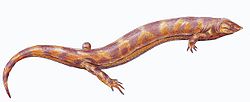- Ostodolepidae
-
Ostodolepidae
Temporal range: Early Permian
Pelodosotis elongatum Scientific classification 
Kingdom: Animalia Phylum: Chordata Class: Amphibia Order: †"Microsauria" Suborder: †Tuditanomorpha Family: †Ostodolepidae
Romer, 1945Genera Ostodolepidae is an extinct family of tuditanomorph microsaurs. They are unique among microsaurs in that they were large, reaching lengths of up to 2 feet (61 cm), terrestrial, and presumably fossorial.[1] Ostodolepid remains have been found from Early Permian beds in Texas and Oklahoma.[2]
Ostodolepids have elongated trunks, with small, robust limbs and shortened tails. The occiput is high, but the skull narrows toward the snout. The snout is pointed and projects past the jaw. In dorsal view, the skull is roughly triangular. The ventral temporal margin is emarginated. At the back of the skull, there is a large cavity between the supraoccipital and the skull roof. The skull is well ossified, with tight sutures between bones. The skull roof is relatively smooth, although scattered pits and grooves are usually present. There are 32 to 45 presacral vertebrae, and three sacral vertebrae.[2]
References
- ^ Anderson, J.S.; Scott, D.; and Reisz, R.R. (2009). "Nannaroter mckinziei, a new ostodolepid ‘microsaur’ (Tetrapoda, Lepospondyli, Recumbirostra) from the Early Permian of Richards Spur (Ft. Sill), Oklahoma". Journal of Vertebrate Paleontology 29 (2): 379–388. doi:10.1671/039.029.0222.
- ^ a b Carroll, R. L.; and Gaskill, P. (1978). "The Order Microsauria". Memoirs of the American Philosophical Society 126.
Goniorhynchidae RhynchonkosGymnarthridae Hapsidopareiontidae Hapsidopareion · Llistrofus · Ricnodon · SaxonerpetonOstodolepidae Pantylidae Pantylus · TrachystegosTrihecatontidae TrihecatonTuditanidae Related categories Carboniferous amphibians · Permian amphibiansCategories:- Prehistoric amphibian stubs
- Prehistoric amphibians of North America
- Permian amphibians
Wikimedia Foundation. 2010.
